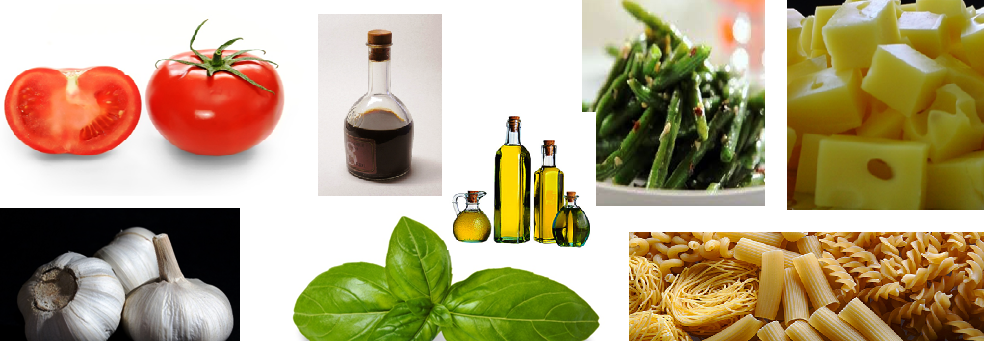Italian cuisine follows the Mediterranean pattern of eating—it focuses on simple, natural ingredients, such as tomatoes, garlic, olive oil, dark leafy greens and whole grains, making it one of the world’s healthiest diets. Research suggests that the benefits of a Mediterranean-style eating pattern may include improved weight loss, better control of blood-glucose (sugar) levels and reduced risk of depression. Find out which essential ingredients of Italian cuisine you should add to your diet.
1. A date with Olive Oil, Cheese, Balsamic vinegar
Make olive oil, which is high in monounsaturated fat, your go-to cooking oil. By replacing butter with olive oil—the most commonly used oil in the Mediterranean—you’ll cut back on saturated fat, help lower “bad” LDL cholesterol and boost levels of “good” HDL cholesterol. In addition, extra-virgin olive oil is high in antioxidants called polyphenols that have been linked to heart health.Try eating like an Italian by dressing your salad greens with a drizzle of extra-virgin olive oil and a squeeze of lemon or use olive oil to sauté fresh vegetables. You can even use olive oil in place of butter in baking.
Cheese is traditionally made in Italy from the milk of water buffaloes, mozzarella is now made mainly from cow’s milk. It melts beautifully, making it the cheese of choice for pizza.
Balsamic vinegaris used in marinades, dressings, and fruit-based desserts, balsamic vinegar is generally darker, thicker, sweeter, and more complex than red or white wine vinegar. Syrupy, highly concentrated traditional Italian balsamics, aged for a minimum of 12 years in oak barrels, are best reserved for undiluted uses; drizzle over fruit or vegetables to appreciate the intense flavor.
2. Finding health withWhole Grains/Dried pasta/Arborio rice
Historically, unrefined grains (whole wheat pasta, whole grain bread, barley, whole wheat couscous) are the base of most Mediterranean diets. Leaving the grains whole lowers their glycemic index, so they are digested more slowly and produce gentler rises in glucose and insulin than refined versions; they also retain all their fiber, magnesium, vitamin E and other antioxidant phytochemicals. Diets rich in whole grains may protect against heart disease, diabetes and other chronic diseases. Top toasted whole-grain bread with diced tomatoes, garlic and basil and toss whole-wheat pasta with olive oil, garlic and Parmesan cheese. A combination of flour, water, and salt, dried pasta is a quintessential comfort food and the basis of many Italian dishes. Another form of whole grain used in Italian cuisine is a short-grained rice with high starch content, Arborio releases starch and thickens when cooked at length over low heat, making it ideal for creamy risottos. O the other hand flour used such as Semolina and double 00 are two high-quality flours often preferred for making homemade pasta, but all-purpose flour will suffice for making fresh pasta and pizza dough.
3. Beans
Beans are an essential, satisfying and healthy ingredient often found in Italian cuisine. Aim to swap out some of your meat and get your protein from beans and other legumes like lentils and chickpeas. By displacing meat, you’ll lower your saturated-fat intake while adding healthful nutrients, like fiber and antioxidant-rich flavonols. Eaten daily, combined with grains and starches, beans provide high-quality protein along with folate, calcium, iron and zinc. They also offer healthy, filling doses of fiber (both soluble and insoluble), phytates and phytosterols; studies suggest beans may help manage diabetes, prevent colon cancer and reduce heart disease risk.
Add a dish or two that contain beans and other legumes to your weekly menu. Try our Bean Bolognese for a hearty bean pasta dish, spread pureed beans on homemade pizza or make a minestrone soup with beans.
4. Tomatoes and Garlic
There’s nothing quite like a ripe tomato, whether served on a bed of fresh greens or made into an Italian red sauce to dress a bowl of hearty pasta. Tomatoes are packed with vitamin C and lycopene, a heart-protective antioxidant that may also help prevent some cancers (particularly prostate). Vitamin A, potassium and folate are also among the tomato’s nutritional benefits. Although cooked tomatoes have less vitamin C, their lycopene is more available and antioxidant activity is undiminished.
To boost the tomatoes in the Italian diet, fresh tomatoes are added to salads, soups or pasta dishes, or learn how to make homemade tomato sauce. Or slice a juicy tomato and enjoy the simple, fresh flavor of tomatoes with a piece of whole-grain toast and a sprinkling of grated Parmesan.
Famous (or infamous) for its pungent flavor, garlic is an indispensable ingredient in Italian cuisine. Select heads that are hard, firm, and tight (no broken skin) and that haven’t sprouted.
5. Dark Leafy Greens and seasoning
To be Italian is to appreciate dark leafy vegetables, especially broccoli rabe, an earthy bitter brassica that pairs beautifully with bold ingredients like sausage, anchovy and hot pepper. Dark leafy greens are nutrition superstars, providing plenty of vitamins A, C and K as well as heart-healthy fiber and cancer-fighting antioxidants. Include a generous portion of rich dark leafy greens, such as chard, kale, escarole and collards, either in a salad or sautéed with olive oil, plenty of garlic and a touch of crushed red pepper. Jarred artichoke hearts add delicate flavor when tossed with pasta, salads, or topped on pizza. Olives are tiny fruits that have been cured in salt, water, or lye to offset their bitterness. Used in everything from antipasti to pastas, they’re packed with cholesterol-lowering monounsaturated fats, vitamin E, and antioxidants. Fresh basil is a sweet, aromatic herb is a staple for topping pastas and pizzas. Dried oregano, sage, and thyme on hand to lend earthy flavor and aroma. Red pepper flakes add heat to pastas and pizza
